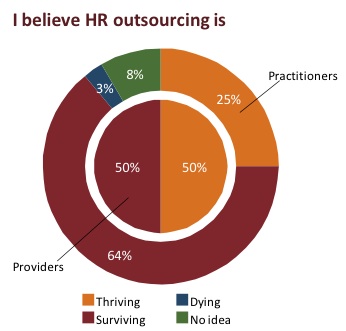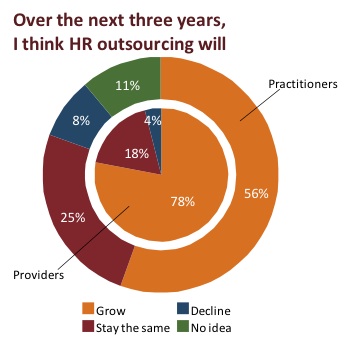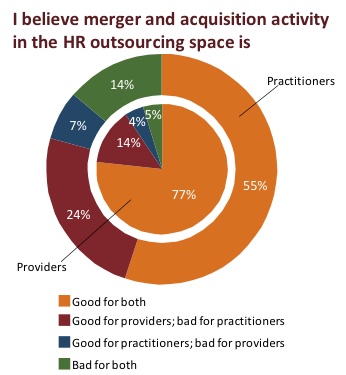 The provider-practitioner disconnect has widened—and narrowed—depending on the question.
The provider-practitioner disconnect has widened—and narrowed—depending on the question.
By Elizabeth Boudrie
We recently launched a short-answer research project asking HR practitioners and providers of HR outsourced services a few questions about the state of HR outsourcing, including questions about where the HR outsourcing industry is now, what works and doesn’t, and where it’s headed. As you’d expect, we found both similarities and differences in their responses. What we found most interesting, though, is the often different approaches the two groups took to answering the questions.
Our research is ongoing;click hereto tell us what you think.
Here’s what we heard.
Thriving, Surviving, or Dying
On the whole providers are more sanguine about the “health” of HR outsourcing than are practitioners, with 50 percent of providers saying HR outsourcing is thriving versus 25 percent of practitioners.
Among practitioners who say that HR outsourcing is thriving, the three most commonly cited reasons were:
- • Regulatory compliance. Practitioners need the assistance of external experts to deal with the ever-increasing complexity and burden of regulatory compliance.
- • Cost containment. Cost structures make it easier to manage expense externally.
- • Specialization. Provider specialization enables them to identify and employ best practices that practitioners may not be able to match.
Providers who say HR outsourcing is thriving cite similar issues—buyer need for expertise and specialization, and the need for assistance with cost management.
However, no provider mentioned the most commonly cited reason practitioners cited—the increasing burden of regulatory compliance—as a reason for continued market growth. Clearly this is a hot-button issue for practitioners around which providers may want to raise their profiles.

Practitioners and providers who said HR outsourcing is surviving (continuing to exist, but not growing at any real pace) generally had similar reasons for that response.
HR outsourcing doesn’t “go away” for at least two reasons:
• Valuable service. On the whole, providers have changed to meet practitioners’ needs, enabling them to survive (the most commonly cited example here was the move to point solutions from enterprise HRO).
• Transition pain and expense. The transition to outsourced solutions was difficult and expensive; while there may not be as much faith in outsourcing as there once was, it’s virtually impossible to go back now.
But it doesn’t grow for at least four reasons:
- • Smaller deal sizes. The large deals simply won’t continue at the same pace as in the past, so there will be fewer large deals and many smaller deals.
- • Slow deal decisions. At the same time, continued economic struggles will slow decision making.
- • Harder sells. While many buyer organizations have bought into the concept, the next level—those who haven’t already jumped on the bandwagon—appear harder to sell on the concept.
- • Unfavorable deal economics. Furthermore, the economics of these lagging buyers’ situations might not work for providers.
What’s Working. . .
When we asked practitioners and providers (in a freeform text question) to tell us what’s working in HR outsourcing, we found they answered the question in fundamentally different ways. Practitioners generally responded with the types of services that are working in HR outsourcing today—i.e., transactional processes. Providers, on the other hand, generally responded with the benefits that they believe clients are realizing through outsourcing. (Of course, both groups offered a variety of different insights—see below—but their perspectives on the question were, in general, quite different.)
What’s working for practitioners:
• Administrative/transactional tasks, such as benefits administration and payroll (this was, by far, the most common comment)
• HRIS hosting/SaaS
• Back-office and employee-facing systems
• Greater efficiency of HR operations
• Increased specialization
What’s working for providers:
• Practitioners and providers have developed a much better understanding of HR outsourcing in general, what works and what doesn’t
• Competition among providers has resulted in evolving technology, improving platforms, and development of best practises
• Enhanced productivity for client organizations
• Cost savings, more efficient processes
• Increased standardization in service delivery, which enables investment in technology and process improvements
• Transactional processing
. . . And What Isn’t
Again here, practitioners and providers responded differently, but in a much more basic way. Virtually every practitioner response focussed on what providers are “doing wrong,” and—as might be expected—virtually every provider response addressed faults on the buyer side.
One complaint that was common to both sides? Innovation—an issue that was raised in greater numbers amongst both practitioners and providers.
What’s not working for practitioners:
• Lack of agility
• Lack of collaboration
• Lack of innovation
• Poor implementation: limited understanding of local/business impact and/or client culture
• Language issues
• Declining service levels
• Truly customized consultative solutions
What’s not working for providers:
• Clients’ aversion to both decision making and risk taking
• Anything that requires strategic input
• Communication amongst employees, outsourced providers and companies
• Change management within buyer companies
• Governance, metrics, investment in staff
• Innovation
Where Is HR Outsourcing Headed?
A majority of both providers and practitioners believe that HR outsourcing will grow in the coming years, although providers have much more faith than do practitioners.
Amongst those who believe HR outsourcing will grow, the reasons are generally the same between the two groups:
• Ongoing pressure to reduce HR costs
• Growing regulation increases the need for expertise
• Internal HR will continue to shift to a more strategic role leaving transactional processes for providers
• SaaS/cloud models drive growth
• Increasing market maturity

And among those who say HR outsourcing will stay the same, again the reasons also are generally similar:
• Buyers will bring activities back in house, due to either economic recovery or poor service/bad experiences (this is also the most common/primary reason cited by those who said they thought the market would decline)
• Spend levels will be the same, but in different areas
• There is not enough innovation to drive increased sales
M&A Activity: Good, Bad, Indifferent
Given the spate of mergers and acquisitions across the HR outsourcing services market, we asked practitioners and providers who, if anyone, benefits from this activity.
The majority of both practitioners and providers say M&A activity is good for both groups, although the providers are much more likely to hold that belief. Nearly a quarter of practitioners say M&As in this space are good for providers but bad for practitioners versus 14 percent of providers. And, although it’s a comparatively low 14 percent, still practitioners are three times more likely to say M&A activity is bad for both than are providers.

Practitioners and providers who say this consolidation is good for both generally cite similar reasons:
• Improves efficiency by removing less viable options from the
market and retaining better options
• Creates stronger providers with higher levels of specialist capability giving buyers the dual benefit of high specialization within a “single point of purchase”
• Engenders better service
• Improves innovation
• Leads to simplification, reduced complexity, increased standardization.
Providers also noted that this activity increases scalability for providers and therefore better product solutions for buyers.
Amongst those who say it’s bad for both, again comments were common between practitioners and providers. The most commonly cited include:
• Fewer choices means less competition means lower standards
• Buyers are negatively impacted by the sometimes painful and messy
merger/acquisition process
What practitioners need from providers over the next three to five years:
• Benchmarking metrics
• Capable, effective HR technology
• Change management
• Consultation, experience, guidance
• Continuous improvement of systems and services
• Cost management
• Flexibility and the ability to take more of the risk of delivery/execution
• Innovation
• Ongoing cost/benefit analyses
What providers believe they must do over the next three to five years to stay competitive and shape the market:
• Build cost-competitive solutions on the utility based model
• Continuously innovate
• Create truly global models that still provide significant cost savings to clients
• Identify more technical products for client companies that will change the way they attract, assess and on-board talent
• Improve service quality and keep cost down
• Increase expertise in SaaS solutions and hybrid outsourced/shared service models
• Work on integration efforts between variety of platforms and models














